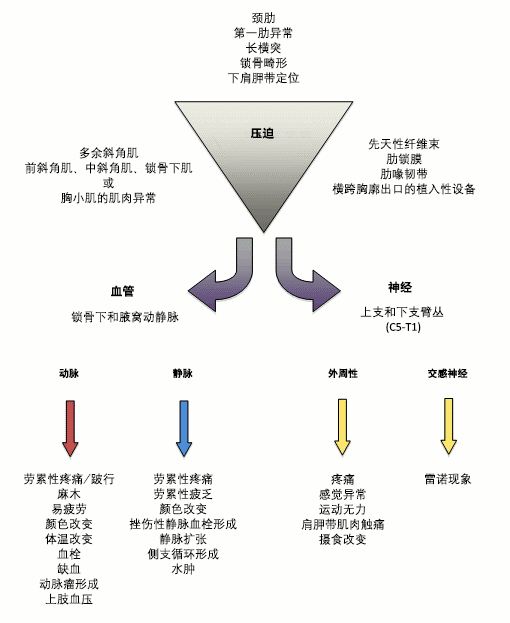患者可能出现神经、静脉或动脉压迫体征和症状,或出现任何症状组合。 医师应该根据患者的症状做相应的进一步研究。
病史和体格检查
许多病史因素会导致患者胸廓出口的神经血管结构受压:外伤(例如,锁骨骨折),重复性高强度的活动,机动车辆撞击,心血管或胸部手术史,颈椎或骨性异常,姿势不良,乳房大或有植入物,肥胖和女性。
有许多常见的检查和方法可用于诊断 TOS,但具体的病史和检查结果取决于压迫的位置。
神经(臂丛)压迫
体征和症状包括:[45]Urschel HC Jr, Razzuk MA, Hyland JW, et al. Thoracic outlet syndrome masquerading as coronary artery disease (pseudoangina). Ann Thorac Surg. 1973;16:239-248.http://www.ncbi.nlm.nih.gov/pubmed/4542290?tool=bestpractice.com
手臂、手和/或手指感觉异常(单侧或双侧)
头、颈、上背、前胸、肩、手臂、前臂和/或手疼痛
锁骨上区、前胸壁、斜角肌、斜方肌或胸小肌触诊触痛
肩胛带和手部运动无力
前臂内侧和手部片状感觉障碍(如神经性[真]胸廓出口综合征)
手部肌肉萎缩(如为神经性[真]胸廓出口综合征,则鱼际肌最明显)
可能存在雷诺现象
手心多汗
潜在“多重挤压”(如果只涉及两个区域,则为“双重挤压 ”)综合征的现象:除了胸廓出口,颈椎和手部之间可能存在多个外周神经压迫点。[41]Urschel HC, Kourlis H. Thoracic outlet syndrome: a 50-year experience at Baylor University Medical Center. Proc (Bayl Univ Med Cent). 2007;20:125-135.http://www.ncbi.nlm.nih.gov/pmc/articles/PMC1849872/http://www.ncbi.nlm.nih.gov/pubmed/17431445?tool=bestpractice.com 在此类情况下,只需较小的压力,每个压迫点就会出现症状。 例如,患者可能并发 TOS、肘部尺神经受压和腕管综合症[46]Mackinnon SE, Dellon AL. Surgery of the peripheral nerve. New York, NY: Thieme Medical; 1988:210-214.
可能存在交感神经压迫:症状包括上肢过冷或过热、出汗。 有时会模拟非典型性胸痛(假性心绞痛)。
静脉(锁骨下及腋窝)压迫
患者可能存在胸廓出口装置植入史(如,中央静脉导管、起搏器)。 体征和症状包括:[14]Illig KA, Doyle AJ. A comprehensive review of Paget-Schroetter syndrome. J Vasc Surg. 2010;51:1538-1547.http://www.jvascsurg.org/article/S0741-5214(09)02518-X/fulltexthttp://www.ncbi.nlm.nih.gov/pubmed/20304578?tool=bestpractice.com[16]Farrar TA, Rankin G, Chatfield M. Venous thoracic outlet syndrome: approach to diagnosis and treatment with focus on affected athletes. Curr Sports Med Rep. 2014;13:81-85.http://www.ncbi.nlm.nih.gov/pubmed/24614420?tool=bestpractice.com
动脉(锁骨下及腋窝)压迫
体征和症状包括:[17]Daniels B, Michaud L, Sease F Jr, et al. Arterial thoracic outlet syndrome. Curr Sports Med Rep. 2014;13:75-80.http://www.ncbi.nlm.nih.gov/pubmed/24614419?tool=bestpractice.com[19]Strukel RJ, Garrick JG. Thoracic outlet compression in athletes: a report of four cases. Am J Sports Med. 1978;6:35-39.http://www.ncbi.nlm.nih.gov/pubmed/646006?tool=bestpractice.com[27]Roos DB. Congenital anomalies associated with thoracic outlet syndrome: anatomy, symptoms, diagnosis, and treatment. Am J Surg. 1976;132:771-778.http://www.ncbi.nlm.nih.gov/pubmed/998867?tool=bestpractice.com[38]Reeser JC. Diagnosis and management of vascular injuries in the shoulder girdle of the overhead athlete. Curr Sports Med Rep. 2007;6:322-327.http://www.ncbi.nlm.nih.gov/pubmed/17883968?tool=bestpractice.com
神经血管 / 联合压迫
患者可能有锁骨骨折病史。
由于增加的或协同的交感神经刺激,可能存在的交感神经和动脉压迫会导致更严重的上肢过热或过冷或出汗症状。 创伤常与交感神经持续性疼痛综合征或反射性交感神经营养不良有关。 交感神经功能亢进(也作复合性区域性疼痛综合征)可能是对疼痛的交感反应,而不是明显的交感神经链压迫反应。[45]Urschel HC Jr, Razzuk MA, Hyland JW, et al. Thoracic outlet syndrome masquerading as coronary artery disease (pseudoangina). Ann Thorac Surg. 1973;16:239-248.http://www.ncbi.nlm.nih.gov/pubmed/4542290?tool=bestpractice.com [Figure caption and citation for the preceding image starts]: 胸廓出口压迫因素、体征和症状源于 Chaney Stewman 医生的个人收藏 [Citation ends].
[Figure caption and citation for the preceding image starts]: 胸廓出口压迫因素、体征和症状源于 Chaney Stewman 医生的个人收藏 [Citation ends].
方法
存在多种刺激性体格检查方法可重现臂丛神经侵犯,并常同时出现桡动脉搏动消失。 如果为阳性或异常,这些方法能产生疼痛和感觉异常的主观症状。 单独一个方法不能用于 TOS 的诊断,用作诊断性试验时应结合患者病史和其他诊断试验。[16]Farrar TA, Rankin G, Chatfield M. Venous thoracic outlet syndrome: approach to diagnosis and treatment with focus on affected athletes. Curr Sports Med Rep. 2014;13:81-85.http://www.ncbi.nlm.nih.gov/pubmed/24614420?tool=bestpractice.com[17]Daniels B, Michaud L, Sease F Jr, et al. Arterial thoracic outlet syndrome. Curr Sports Med Rep. 2014;13:75-80.http://www.ncbi.nlm.nih.gov/pubmed/24614419?tool=bestpractice.com[22]Stewman C, Vitanzo PC Jr, Harwood MI. Neurologic thoracic outlet syndrome: summarizing a complex history and evolution. Curr Sports Med Rep. 2014;13:100-106.http://www.ncbi.nlm.nih.gov/pubmed/24614423?tool=bestpractice.com[47]Adson AW. Cervical ribs: symptoms, differential diagnosis and indications for section of the insertion of the scalenus anticus muscle. J Int Coll Surg. 1951;16:546-559.http://www.ncbi.nlm.nih.gov/pubmed/14888975?tool=bestpractice.com[48]Lord JW, Rosatti LM, Netter F. Thoracic-outlet syndromes. CIBA Clinical Symposia, vol 23, no 2. Summit, NJ: Ciba Pharmaceutical Products; 1971.[49]Roos DB. Thoracic outlet nerve compression. In: Rutherford RB, ed. Vascular surgery. 3rd ed. Philadelphia, PA: WB Saunders; 1989:858-875.[50]Butler DS. Mobilisation of the nervous system. Melbourne, Australia: Churchill Livingstone; 1991:147-160. 方法如下:
Adson氏(斜角肌)试验:绷紧前斜角肌和中肌,缩小间隙,加重锁骨下动脉和臂丛间现存的压迫。 患者深吸一口气并屏住呼吸,充分伸展颈部,头转向一侧。 [Figure caption and citation for the preceding image starts]: Adson试验,绷紧前斜角肌和中肌,减少间隙,放大锁骨下动脉和臂丛间存在的压迫。 患者深吸一口气并屏住呼吸,充分伸展颈部,头转向一侧。 桡动脉闭塞或下降提示存在压迫已获得 Netter Images 的再版许可 [Citation ends].
[Figure caption and citation for the preceding image starts]: Adson试验,绷紧前斜角肌和中肌,减少间隙,放大锁骨下动脉和臂丛间存在的压迫。 患者深吸一口气并屏住呼吸,充分伸展颈部,头转向一侧。 桡动脉闭塞或下降提示存在压迫已获得 Netter Images 的再版许可 [Citation ends].
肋锁检查(又称霍尔斯特德试验或军姿试验):肩部向下、向后拉伸。 这会使锁骨靠近第一肋,缩小肋锁间隙,从而可能压迫神经血管束。  [Figure caption and citation for the preceding image starts]: 肋锁试验显示,肩部向下和向后,锁骨靠近第一肋而肋锁间隙变窄,趋于压迫神经血管束。 桡动脉脉搏变化,症状表明压迫存在已获得 Netter Images 的再版许可 [Citation ends].
[Figure caption and citation for the preceding image starts]: 肋锁试验显示,肩部向下和向后,锁骨靠近第一肋而肋锁间隙变窄,趋于压迫神经血管束。 桡动脉脉搏变化,症状表明压迫存在已获得 Netter Images 的再版许可 [Citation ends].
过度外展试验:高度外展手臂 180°,牵拉胸小肌、喙突和肱骨头周围的神经血管束。  [Figure caption and citation for the preceding image starts]: 右臂过度外展的解剖结构。 当手臂过度外展 180°时,神经血管束的组成结构被拉至胸小肌腱、肱骨、喙突和头部旁边。 如果桡动脉脉搏减弱,应怀疑存在压迫已获得 Netter Images 的再版许可 [Citation ends].
[Figure caption and citation for the preceding image starts]: 右臂过度外展的解剖结构。 当手臂过度外展 180°时,神经血管束的组成结构被拉至胸小肌腱、肱骨、喙突和头部旁边。 如果桡动脉脉搏减弱,应怀疑存在压迫已获得 Netter Images 的再版许可 [Citation ends].
Roos 试验:双臂呈直角放于肩上,前臂与上臂呈直角。 快速地打开合拢双手,观察是否出现症状。
拉扯测试:手臂外展 90°,肘关节伸直,掌心向前,拇指指向天花板。 然后患者将头侧向弯曲至对侧。 这会拉伸神经丛。
上肢张力试验:上肢所有组织的一系列试验都优先关注正中神经和相关神经丛、神经根。 涉及肩外展、腕关节悬挂和伸展、肩外旋、肘关节伸展、颈部侧屈远离或朝向试验侧。
Wright 式试验:模拟伸懒腰(手臂外旋和外展 180°,同时弯曲肘关节)。
影像学检查
高达 30% 的患者存在骨性异常,常见于颈肋、第一肋铰接或分裂、第一肋和第二肋融合、锁骨畸形或胸廓成形术病史者。[51]Schneider DB, Azakie A, Messina LM, et al. Management of vascular thoracic outlet syndrome. Chest Surg Clin North Am. 1999;9:781-802. 初始颈椎 X 线和/或胸部 X 线能发现以上骨性异常,是所有 TOS 患者的初步诊断检查。
疑似神经性胸廓出口综合征的患者应考虑进行颈部、锁骨和肩部的 MRI 检查,因为它能帮助提供软组织的解剖细节,并能识别异常信号,如先天性纤维束。[5]Wilbourn AJ. Thoracic outlet syndromes. Neurol Clin. 1999;17:477-497.http://www.ncbi.nlm.nih.gov/pubmed/10393750?tool=bestpractice.com[22]Stewman C, Vitanzo PC Jr, Harwood MI. Neurologic thoracic outlet syndrome: summarizing a complex history and evolution. Curr Sports Med Rep. 2014;13:100-106.http://www.ncbi.nlm.nih.gov/pubmed/24614423?tool=bestpractice.com MRI 平扫通常已经足够,除非怀疑存在血管病变。[52]American College of Radiology. ACR appropriateness criteria: imaging in the diagnosis of thoracic outlet syndrome. http://www.acr.org/ (last accessed 29 July 2016).https://acsearch.acr.org/docs/3083061/Narrative/ 进行正位和肩外展位成像,以最好地定位卡压部位。
如果疑似动脉胸廓出口综合征,CT 血管造影术是初步的诊断性影像学检查。 如果疑似动脉胸廓出口综合征,多普勒超声检查是初步的诊断性影像学检查。 最好在患者处于正位和肩外展位时实行 CT 血管造影和多普勒超声检查。[52]American College of Radiology. ACR appropriateness criteria: imaging in the diagnosis of thoracic outlet syndrome. http://www.acr.org/ (last accessed 29 July 2016).https://acsearch.acr.org/docs/3083061/Narrative/ 也可用磁共振血管造影或静脉造影术替代。 也可执行常规动脉造影术,但已被其他影像学检查取代用于诊断,目前主要用于动脉胸廓出口综合征手术干预期间。 静脉造影术是用于检测静脉胸廓出口综合征的诊断标准,但多用于替代性成像检查不具有诊断意义的情况下,或计划进行手术干预时。[16]Farrar TA, Rankin G, Chatfield M. Venous thoracic outlet syndrome: approach to diagnosis and treatment with focus on affected athletes. Curr Sports Med Rep. 2014;13:81-85.http://www.ncbi.nlm.nih.gov/pubmed/24614420?tool=bestpractice.com[17]Daniels B, Michaud L, Sease F Jr, et al. Arterial thoracic outlet syndrome. Curr Sports Med Rep. 2014;13:75-80.http://www.ncbi.nlm.nih.gov/pubmed/24614419?tool=bestpractice.com
神经传导检查
电诊法检查是发现臂丛受侵犯的有效手段。[53]Machanic BI, Sanders RJ. Medial antebrachial cutaneous nerve measurements to diagnose neurogenic thoracic outlet syndrome. Ann Vasc Surg. 2008;22:248-254.http://www.ncbi.nlm.nih.gov/pubmed/18346579?tool=bestpractice.com 可能患真性神经性胸廓出口综合征的所有患者应进行确认性神经传导检查。 也可用肌电图来除外其他诊断(例如,腕或肘管综合征,或颈神经根病)。[22]Stewman C, Vitanzo PC Jr, Harwood MI. Neurologic thoracic outlet syndrome: summarizing a complex history and evolution. Curr Sports Med Rep. 2014;13:100-106.http://www.ncbi.nlm.nih.gov/pubmed/24614423?tool=bestpractice.com
典型临床表现的真性神经性胸廓出口综合征的神经传导特征性检查发现包括:正中神经运动幅度减少,前臂内侧皮肤和尺神经的感觉幅度降低。[5]Wilbourn AJ. Thoracic outlet syndromes. Neurol Clin. 1999;17:477-497.http://www.ncbi.nlm.nih.gov/pubmed/10393750?tool=bestpractice.com 特别是,正中神经的运动复合肌肉动作电位(记录鱼际肌,通常为拇短展肌)的振幅非常低,而正中感觉神经动作电位(记录第二指)则是正常的。 此外,前臂内侧皮肤感觉神经(供给前臂内侧)动作电位振幅不存在或非常低。 尺神经感觉神经动作电位(记录第五指)为轻微至中度低振幅。
为检查尺神经,患者于检查台上,手臂肘部完全伸展,肩部外展约 20°,以方便在尺神经走行上方进行刺激。使用特定刺激单位,通过 4 个点来刺激尺神经,在所有点给予电刺激,以获得最大反应。 [Figure caption and citation for the preceding image starts]: 神经传导速度测量技术。 当电流通过电极时,示波器上会出现一个“标记”源于 Harold C. Urschel Jr 医生的个人收藏 [Citation ends].
[Figure caption and citation for the preceding image starts]: 神经传导速度测量技术。 当电流通过电极时,示波器上会出现一个“标记”源于 Harold C. Urschel Jr 医生的个人收藏 [Citation ends].
进行肌电图检查时,应评估所有由颈椎神经根和臂丛神经支配的部位,包括椎旁肌。 解读异常的区域可以帮助识别压迫的部位。
其他检查
定向性肌肉阻滞不仅可以帮助诊断,还可用于神经性胸廓出口综合征的手术干预中。 具体地就是,将局麻药注入前斜角肌和胸小肌。 针对胸小肌综合征患者,如果症状是由斜角肌间沟三角臂丛神经压迫引起的,则肌肉阻滞可缓解症状。[5]Wilbourn AJ. Thoracic outlet syndromes. Neurol Clin. 1999;17:477-497.http://www.ncbi.nlm.nih.gov/pubmed/10393750?tool=bestpractice.com[6]Sanders RJ, Hammond SL, Rao NM. Thoracic outlet syndrome: a review. Neurologist. 2008;14:365-373.http://www.ncbi.nlm.nih.gov/pubmed/19008742?tool=bestpractice.com[10]Nichols AW. Diagnosis and management of thoracic outlet syndrome. Curr Sports Med Rep. 2009;8:240-249.http://www.ncbi.nlm.nih.gov/pubmed/19741351?tool=bestpractice.com[12]Sanders RJ, Rao NM. The forgotten pectoralis minor syndrome: 100 operations for pectoralis minor syndrome alone or accompanied by neurogenic thoracic outlet syndrome. Ann Vasc Surg. 2010;24:701-708.http://www.ncbi.nlm.nih.gov/pubmed/20471786?tool=bestpractice.com
静脉胸廓出口综合征的患者可以考虑全血细胞计数和凝血功能检查。 如果不存在其他病因(例如,挫伤性静脉血栓形成、植入设备、先天性畸形),以上两种检查可以帮助评估血液高凝状态,即静脉血栓的病因之一。
 [Figure caption and citation for the preceding image starts]: 胸廓出口压迫因素、体征和症状源于 Chaney Stewman 医生的个人收藏 [Citation ends].
[Figure caption and citation for the preceding image starts]: 胸廓出口压迫因素、体征和症状源于 Chaney Stewman 医生的个人收藏 [Citation ends]. [Figure caption and citation for the preceding image starts]: Adson试验,绷紧前斜角肌和中肌,减少间隙,放大锁骨下动脉和臂丛间存在的压迫。 患者深吸一口气并屏住呼吸,充分伸展颈部,头转向一侧。 桡动脉闭塞或下降提示存在压迫已获得 Netter Images 的再版许可 [Citation ends].
[Figure caption and citation for the preceding image starts]: Adson试验,绷紧前斜角肌和中肌,减少间隙,放大锁骨下动脉和臂丛间存在的压迫。 患者深吸一口气并屏住呼吸,充分伸展颈部,头转向一侧。 桡动脉闭塞或下降提示存在压迫已获得 Netter Images 的再版许可 [Citation ends]. [Figure caption and citation for the preceding image starts]: 肋锁试验显示,肩部向下和向后,锁骨靠近第一肋而肋锁间隙变窄,趋于压迫神经血管束。 桡动脉脉搏变化,症状表明压迫存在已获得 Netter Images 的再版许可 [Citation ends].
[Figure caption and citation for the preceding image starts]: 肋锁试验显示,肩部向下和向后,锁骨靠近第一肋而肋锁间隙变窄,趋于压迫神经血管束。 桡动脉脉搏变化,症状表明压迫存在已获得 Netter Images 的再版许可 [Citation ends]. [Figure caption and citation for the preceding image starts]: 右臂过度外展的解剖结构。 当手臂过度外展 180°时,神经血管束的组成结构被拉至胸小肌腱、肱骨、喙突和头部旁边。 如果桡动脉脉搏减弱,应怀疑存在压迫已获得 Netter Images 的再版许可 [Citation ends].
[Figure caption and citation for the preceding image starts]: 右臂过度外展的解剖结构。 当手臂过度外展 180°时,神经血管束的组成结构被拉至胸小肌腱、肱骨、喙突和头部旁边。 如果桡动脉脉搏减弱,应怀疑存在压迫已获得 Netter Images 的再版许可 [Citation ends]. [Figure caption and citation for the preceding image starts]: 神经传导速度测量技术。 当电流通过电极时,示波器上会出现一个“标记”源于 Harold C. Urschel Jr 医生的个人收藏 [Citation ends].
[Figure caption and citation for the preceding image starts]: 神经传导速度测量技术。 当电流通过电极时,示波器上会出现一个“标记”源于 Harold C. Urschel Jr 医生的个人收藏 [Citation ends].